If you think getting a new GPU will solve all your gaming needs, you’re right. But who has $500, $600, or $1000 lying around in this economy, waiting for a newest-gen GPU purchase? I know I don’t. Thankfully, GPU prices are dropping as of last month, and you can find better deals as each day passes. In light of that, it would be wise to revisit some older graphics cards and see how they do in 2023.
This article is an RX 570 vs GTX 1650 comparison that will walk you through every aspect you need to know before you hit that “Purchase” button. You’ll also find a few good deals in this article so that you can get your hands on one of them today if you like what you hear, of course. So let’s get to it.
RX 570 vs GTX 1650 – Quick Comparison
| RX 570 | Specs | GTX 1650 |
|---|---|---|
| Polaris 20 XL (215-0910052) | GPU | TU117-300-A1 (GDDR5 & GDDR6) TU116-150-KA-A1 TU106-125-KAB-A1 TU116-250-KA-A1 (Super) |
| PCIe 3.0 x16 | Interface | PCIe 3.0 x16 |
| 2,048 (Stream Processors) | Cores | 896 (CUDA Cores) |
| 128 | TMUs | 56 |
| 1,168 MHz | Base Clock (Founders Edition) | 1,485 MHz |
| 1,244 MHz | Boost Clock (Founders Edition) | 1,665 MHz |
| 8 GB GDDR5 4 GB GDDR5 | Memory | 4 GB GDDR5 4 GB GDDR6 |
| 1,750 MHz (7 Gbps effective) | Memory Speed | 2,000 MHz (8 Gbps effective) |
| 224.0 GB/s | Bandwidth | 128.1 GB/s |
| 256-bit | Memory Bus | 128-bit |
| 150 W | TDP (Founders Edition) | 75 W (TU117) 80 W (TU116) 90 W (TU106) 100 W (Super) |
| 450 W | Required PSU (Founders Edition) | 300 W |
| 74℃ (165.2℉) | Max Recorded Temp (Founder Edition) | 65℃ (149℉) |
| 38dB | Max Fan Noise (Founders Edition) | 45dB |
| 1x DVI 1x HDMI 2.0b 3x DisplayPort 1.4a | Outputs (Founders Edition) | 1x DVI 1x HDMI 2.0 1x DisplayPort 1.4a |
RX 570
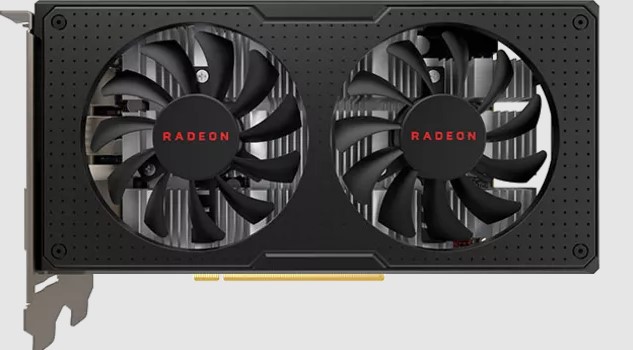
The AMD Radeon RX 570 is a mid-range card released in April 2017. AMD based it on the same GPU as the RX 580 with the same number of cores physically present (2,304), 256 of which are locked to achieve a specific shader target of 2,048. Two versions were released, featuring 4 and 8 GB GDDR5 VRAM. It features DirectX 12 support and offers solid performance at lower resolutions.
AMD is one of the oldest companies in the PC industry. Founded over half a century ago, AMD has developed some of the best CPUs and GPUs and is now heavily involved in creating cloud computing infrastructure.
Pros:
- Larger VRAM
- More cores
- Better performance
- Higher bandwidth
Cons:
- Higher TDP
- Heats more
GTX 1650
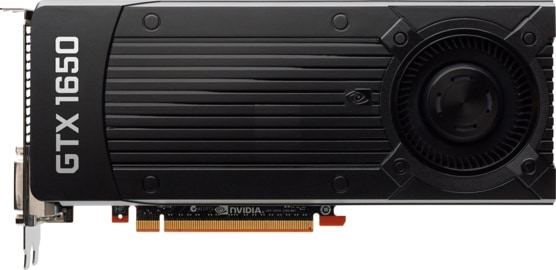
The Nvidia GeForce GTX 1650 is an entry-level card based on Nvidia’s Turing architecture. It supports DirectX 12, meaning it can theoretically handle every modern game. How well it can do this with just 4 GB VRAM and 896 cores is another matter.
The first of four GTX 1650 cards was released in April 2019, featuring 896 CUDA Cores, 56 TMUs, and 4 GB GDDR5 and GDDR6 VRAM on a 128-bit BUS. Nvidia released the subsequent versions in 2020, two of which had different GPU variants (same core count), all paired with GDDR6 VRAM. A GTX 1650 Super variant was also released with GDDR6 VRAM at the end of 2019.
Nvidia was the first company to develop a GPU back in the 1990s. They successfully predicted what was coming in the then almost non-existent gaming industry and have catered to it for a long time since. Starting in 2015, Nvidia shifted its focus to Deep Learning projects and now powers virtually every AI development project worldwide.
Pros:
- Lower TDP
- Higher memory clock
- Higher core clock
- Better shaders
Cons:
- Smaller VRAM
- Fewer cores
GTX 1650 vs RX 570 – Key Specifications
Architecture
Polaris
Polaris, also known as GCN 4.0, offers better performance than its predecessor without making any groundbreaking changes. Advancements in production processes allowed AMD to create the same microarchitecture that functioned in a better way. This enabled higher clock speeds and faster VRAM, and solid performance as a result.
Turing
Turing proved itself in the RTX 20 series. Nvidia decided to use a somewhat impoverished version of Turing in the GTX 16 series without the RT and Tensor cores. It turned out to be a smart move that offered users a low-cost alternative to RTX cards.
Winner: GTX 1650
Also Read: Differences between RTX and GTX
Clock Speeds & Overclocking
You have probably heard the term “clock speed.” It’s the frequency at which your GPU operates. CPUs, RAM, and VRAM have them as well. GPU speeds used to be static and could be altered through overclocking. Today, they fluctuate between “base” and “boost.”
Base speed is the lowest speed you should expect when your card is under load, but it can fall below that when you don’t need the full might of your card to tackle the task at hand (i.e., older games). Your card will also fall far below the base speed whenever idle (so don’t freak out).
Boost speed is the highest speed your card can achieve without overclocking, but this, too, is not always true. I’ve seen mine reach above the official boost clock without any overclocking on my part. The base clock speed of the RX 570 is 1,168 MHz, while its boost clock reaches 1,244 MHz, a pale comparison to the GTX 1650’s 1,485 MHz base and 1,665 MHz boost clock.
You can use dedicated software to reach beyond these speeds (overclocking), and many third-party variants are produced factory-overclocked (look for the ‘OC’ in their names). It’s best to use AMD’s software for AMD cards and Nvidia’s for Nvidia cards. Many people also use MSI Afterburner. My advice is to not fiddle around with GPU settings unless you know what you’re doing.
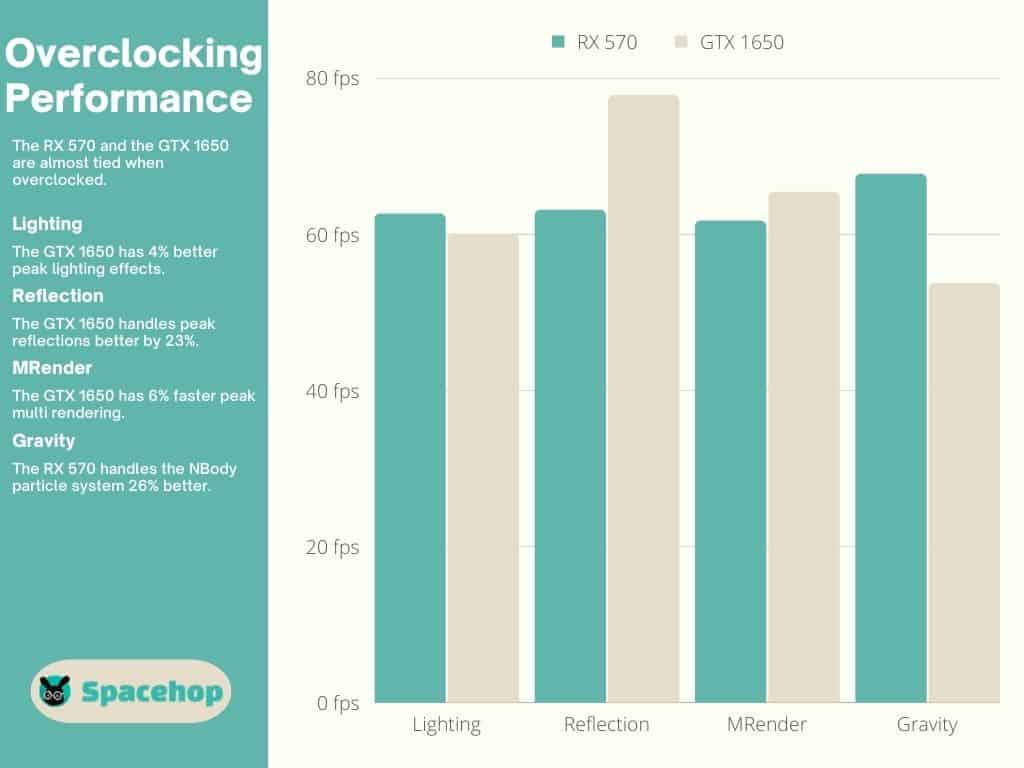
The performance gap that you’ll see later is significantly smaller when both cards are overclocked.
| Best RX 570 Variants | Boost Clock | Best GTX 1650 Variants | Boost Clock |
|---|---|---|---|
| Sapphire NITRO+ RX 570 | 1,340 MHz | EVGA GTX 1650 XC Ultra | 1,875 MHz |
| Sapphire NITRO+ RX 570 8 GB | 1,340 MHz | Colorful iGame GTX 1650 AD Special OC | 1,860 MHz |
| Dataland RX 570 X-Serial | 1,320 MHz | Colorful iGame GTX 1650 Ultra | 1,860 MHz |
| PowerColor Red Devil RX 570 OC | 1,320 MHz | EVGA GTX 1650 SC Ultra | 1,860 MHz |
| AREZ STRIX RX 570 GAMING OC | 1,300 MHz | EVGA GTX 1650 XC | 1,860 MHz |
Things totally switch up when comparing the GTX 1650 Super vs RX 570. The GTX 1650 Super has the same base clock speed as the regular GTX 1650, while its boost clock speed is higher, reaching 1,725 MHz. Of the 56 GTX 1650 Super third-party variants that I found, 26 are factory-overclocked, reaching boost clock speeds of up to 1,785 MHz (officially).
Winner: GTX 1650
Also Read: How to Undervolt your CPU and GPU
Cores
A Graphic Processing Unit is a parallel processor similar to your CPU. The difference is how many cores are featured in each type of processing unit. GPUs have hundreds, or thousands of cores, depending on what generation you’re looking at.
Four different GPUs were used in five different versions of the GTX 1650. The TU117 (GDDR5) was released first, followed by the GTX 1650 Super (GDDR6), the only version with more cores (1280). Three more versions were released by Nvidia, one based on the original TU117 GPU, one on the TU116, and one on the TU106.
The RX 570 has the potential for more cores (2,304), but AMD chose to lock them, aiming for a lower shader count (2,048) than the other card sharing the same GPU, the RX 580. The GTX 1650 has a much lower core count at 896. Merely counting the cores is not enough; you have to consider how they are used.
Shaders
You’ve probably heard the term “shaders” while reading about GPUs. Shaders are generic programs that use your cores to create aspects critical to 3D rendering. DirectX is a prime example of a shader language. Several are used simultaneously, in fact. The GTX 1650 uses newer versions of these shading languages, including DirectX 12_1 and 12_2 (TU106). The RX 570 uses DirectX 12_0.
| RX 570 | Shaders | GTX 1650 |
|---|---|---|
| 12 (12_0) | DirectX | 12 (12_1) 12 (12_2) feature in the TU106 version |
| 4.6 | OpenGL | 4.6 |
| 2.1 | OpenCL | 3.0 |
| 1.2 | Vulkan | 1.3 |
| 6.4 | Shader Model | 6.6 |
This is one of the reasons why the GTX 1650 performs similarly to the RX 570, even though it has less than half the cores and VRAM.
TMUs
Another critical aspect in 3D rendering is how many Texture Mapping Units a card has. They are also considered part of the “core configuration” of GPUs. Almost always, AMD packs more TMUs than Nvidia does, and almost always, AMD cards handle textures much better. The RX 570 has 128 TMUs, while the GTX 1650 has less than half of that — 56.
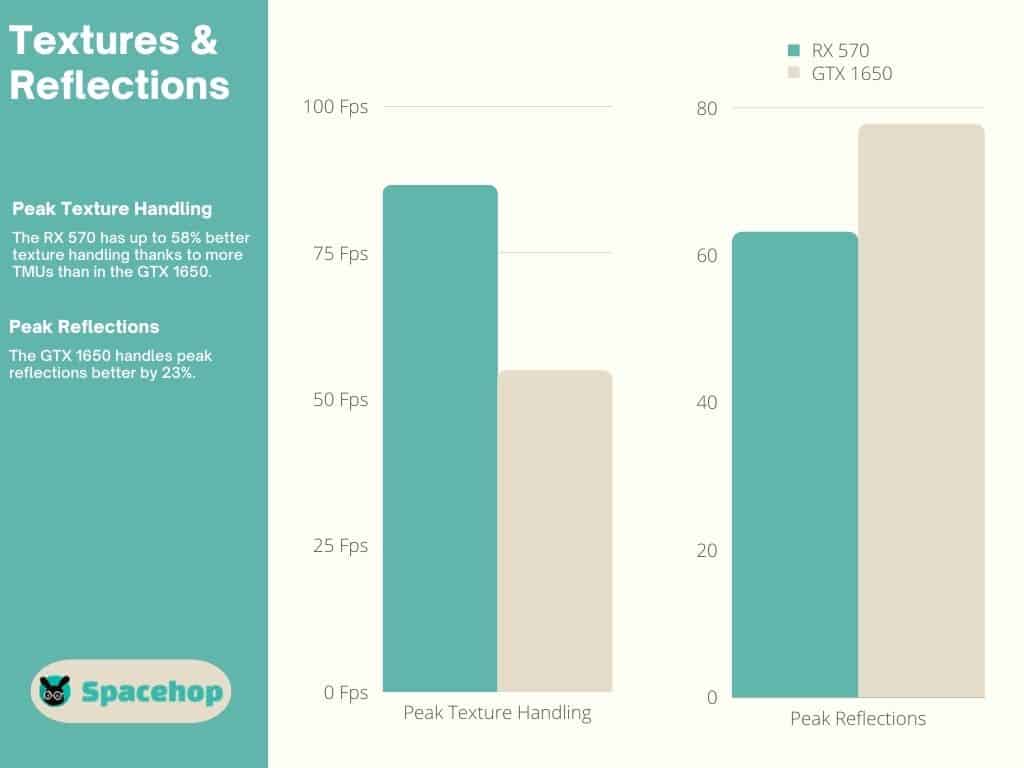
Textures can weigh heavily on GPU performance, even in very old games such as SimCity 4 (released January 2003) so having solid texture handling is very important.
Winner: RX 570
VRAM & Memory Specs
The RX 570 was released with two VRAM configurations, 4 GB and 8 GB GDDR5 VRAM, paired with a 256-bit memory BUS. Both have a clock speed of 1,750 MHz (7 Gbps effective) and a bandwidth of 224 GB/s. I’d choose the 8 GB version any day of the week because it’s the more future-proof of the two.
The GTX 1650 was first released with a 4 GB GDDR5 VRAM paired with a 128-bit BUS delivering 8 Gbps (2,000 MHz) and a bandwidth of 128 GB/s. That same year, the GTX 1650 Super variant was released, featuring a GDDR6 VRAM delivering bandwidth of 192 GB/s on the same 128-bit BUS.
The following year (2020), three more versions were released featuring GDDR6 VRAM, all paired with the same 128-bit BUS and delivering 192 GB/s. Faster VRAM is another reason why the GTX 1650 can challenge the RX 570 in performance.
Winner: RX 570
Also Read: RAM vs VRAM: What are the key differences?
Performance
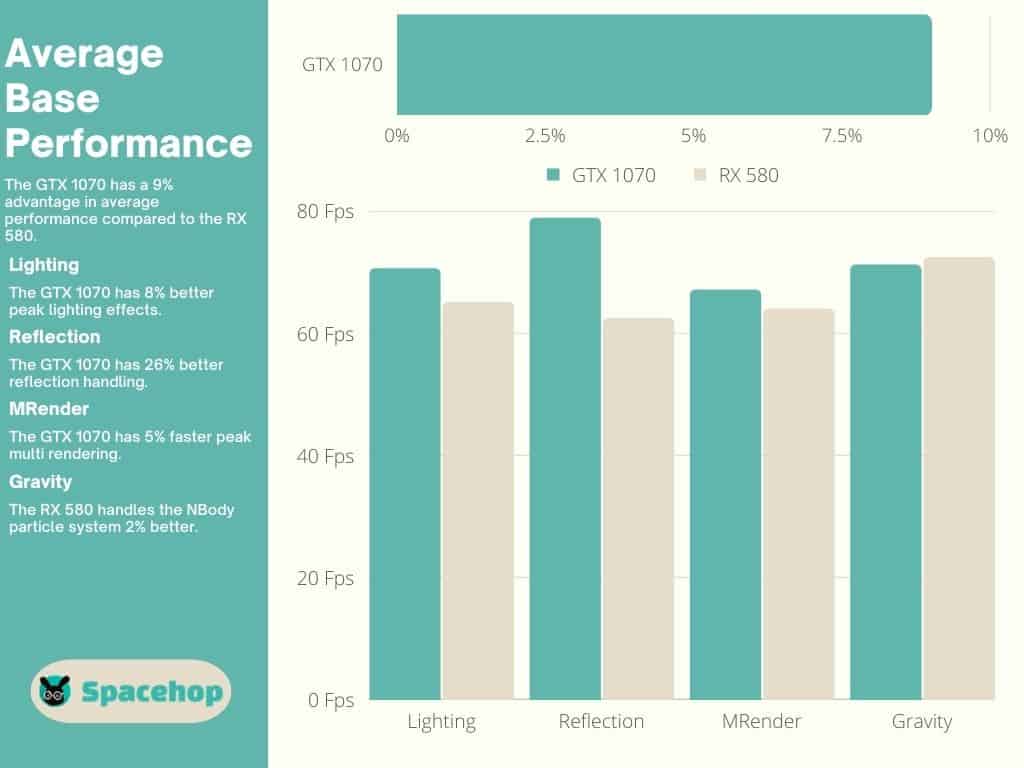
There is no doubt that the RX 570 is the better performer on average, but you can forget about ultra settings when playing even ten-year-old titles. You’ll find that even high settings are a stretch in some cases. Also, 4K gaming is not very appealing on either card, so I decided not to waste time testing it further. Of course, there are games where this is not the case, but I speak in average terms after testing in 11 various titles.
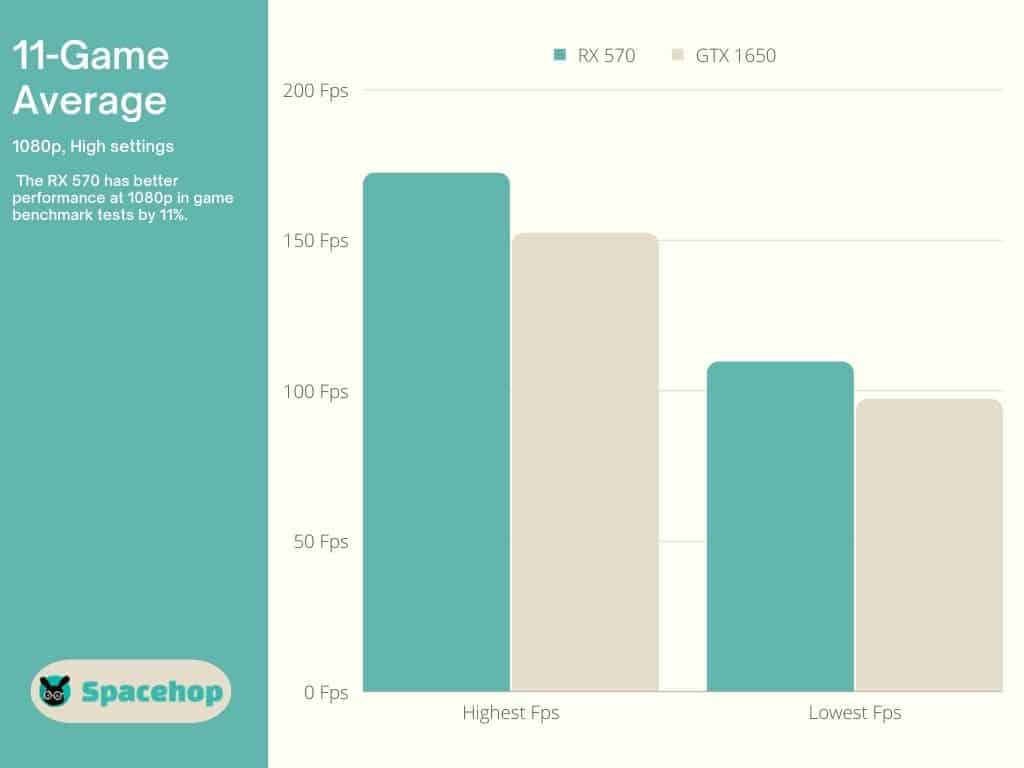
At 1080p, the RX 570 has an 11% advantage on average.
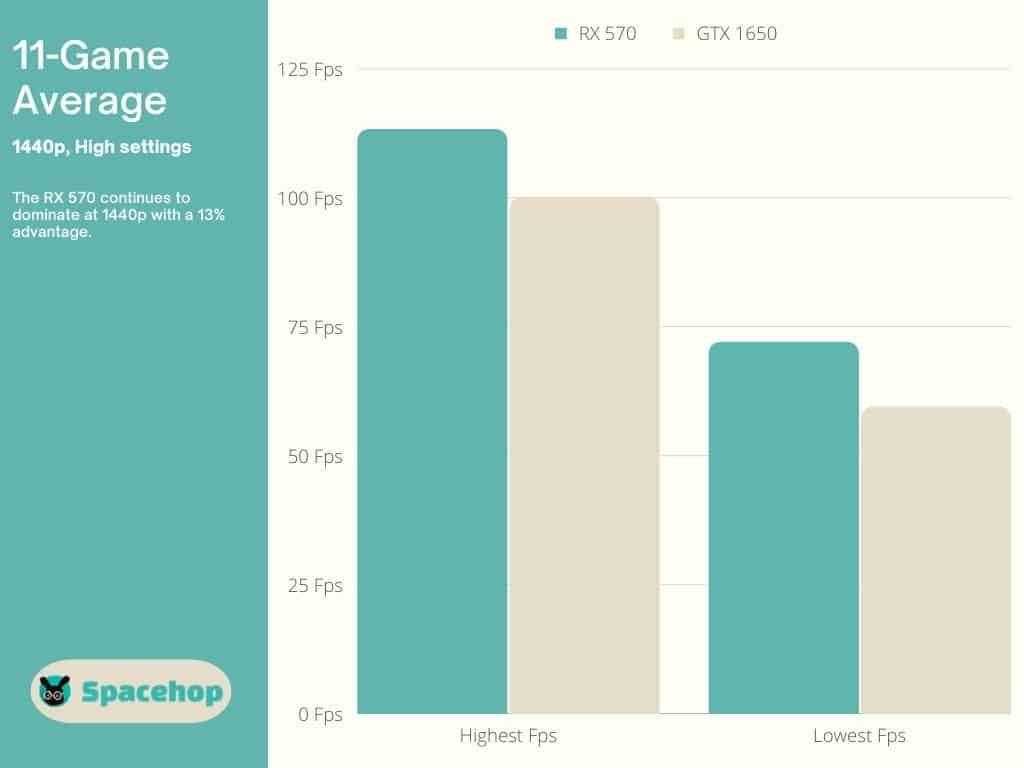
At 1440p, the RX 570 raises its advantage to 13% on average.
These are average benchmark tests, and your results may differ depending on your CPU, RAM, and other aspects. User tests drop the average to 8%, 4% below the benchmark average.
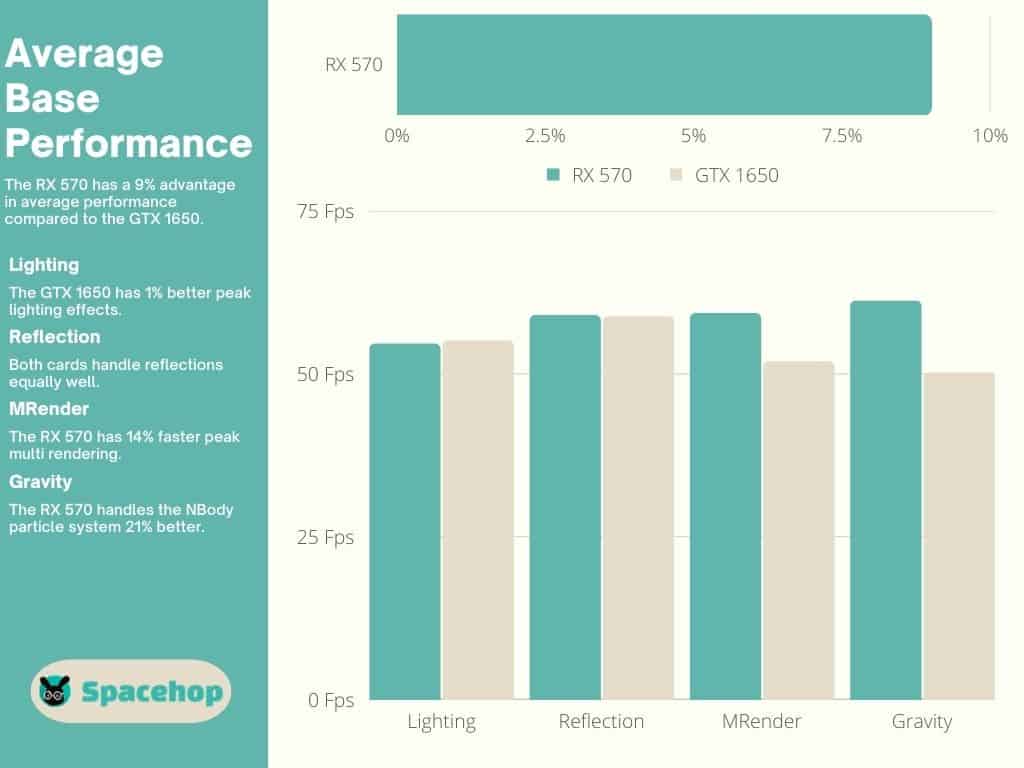
Things change quickly when comparing the GTX 1650 Super vs RX 570. The GTX 1650 Super leaves the base GTX 1650 in the dust. According to user tests, the GTX 1650 Super offers up to 40% better performance, and it also beats the RX 570 by up to 27%.
Winner: RX 570
Connectivity
The RX 570 Founders Edition (FE) has more connection options than the GTX 1650 FE. It features one DVI port, one HDMI port, and three DisplayPorts. That’s five screens, potentially. The GTX 1650 FE supports less, with only one DisplayPort, one DVI port, and one HDMI port. Most third-party variant cards have altered configurations.
Winner: RX 570
TDP
TDP refers to two things, Thermal Design Power and Thermal Design Point. The first one is a measure of how much power a subsystem is allowed to draw from your PSU. The second is how much heat that subsystem is allowed to produce.
The RX 570 draws 150 W and requires a 450 W PSU. It produced a maximum temperature of 74℃ (165.2℉) during testing. Things are a bit more complicated in the GTX 1650’s case. Because there were five versions in total, using four different GPUs, the TDPs differ a bit.
| GTX 1650 GPU Variant | TDP |
|---|---|
| TU117-300-A1 (GDDR5) | 75 W |
| TU117-300-A1 (GDDR6) | 75 W |
| TU116-150-KA-A1 | 80 W |
| TU106-125-KAB-A1 | 90 W |
| TU116-250-KA-A1 (Super) | 100 W |
The base GTX 1650 draws 75 W and requires a 300 W PSU. The same goes for the GDDR6 version based on the same GPU variant. The three other GPU variants use 80 W, 90 W, and 100 W, still below the 150 W drawn by the RX 570. I reached a maximum temperature of 65℃ (149℉) while testing the GTX 1650 base model.
When considering the GTX 1650 Super vs RX 570, I found it produced slightly more heat, hitting 66℃. That’s not a notable difference considering it offers much better performance than the RX 570, let alone the base 1650.
Winner: GTX 1650
Pricing & Availability
The RX 570 8 GB was released at a $169 MSRP. That was a long time ago, and I found only one deal with a price close to that. This Sapphire Nitro+ variant (No.2 on the best-ever list) is priced at just 17% above. This MSI Gaming variant and this ASRock Phantom Gaming variant are both priced 136% above MSRP. It’s this XFX RS Black Edition that takes the cake, priced at 402% above MSRP!
The GTX 1650 was priced at $149 when released. They’re not priced much above that now, either. You can grab a Zotac Gaming variant 13% above MSRP. An MSI Gaming variant is the next best deal at 23% above, followed by these EVGA Ultra Gaming and GIGABYTE variants priced 26% above MSRP. An ASUS variant will set you back the most priced at 38% above MSRP.
These prices and percentages were such at the time of writing and are subject to change.
Conclusion
So, what do the results of this GTX 1650 vs RX 570 comparison tell us? Well, the RX 570 is the better card, but its prices are generally higher than the GTX 1650’s. Neither card is very good at high-requirement games, high resolutions, and higher settings. Dialing down on details would provide a solid gaming experience without much stuttering, but who wants to play at medium?!
Are they worth your money in 2023? I don’t think so. There are much better cards out there for less or the same amount of money. The GTX 1650 Super (for example) outperforms the RX 570 by 27% according to user tests, and you can grab one at similar prices as the regular GTX 1650.